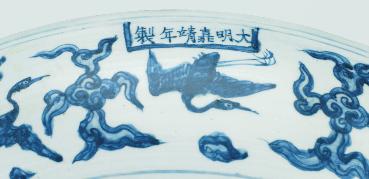
31.
LARGE DISH
WHITE PORCELAIN DECORATED IN UNDERGLAZE BLUE
JINGDEZHEN KILNS, JIANGXI PROVINCE
MING DYNASTY, JIAJING MARK AND PERIOD (1522–1566)
HEIGHT 10.5 CM; RIM DIAMETER 67.2 CM;
FOOT DIAMETER 47.3 CM
INV. NO. 673
Large, shallow, circular dish, with a concave
centre, flat rim, convex base with spiral and
radial chatter marks and a low inverted foot.
Heavily potted and covered with bluish glaze,
except for the edge of the foot and the base,
which turned orange because of contact with
the kiln atmosphere.
The decoration, painted in vivid underglaze
blue, comprises two plump, sinuous dragons
covered with outlined scales, with long horns
and five claws, which, despite being
confronted do not appear to be fighting.
They glide in opposite directions among
clouds, forming a circular medallion
surrounded by four clouds with centres
similar to a
ruyi
head, all within a double
circle. The cavetto is filled with a large scroll
with sixteen lotus flowers above which rise
auspicious symbols: flaming pearl, lozenge,
rhinoceros horns, crossed scrolls with four
78 .
PORCELAIN OF THE YUAN (1279–1368) AND MING (1368–1644) DYNASTIES
points and
ruyi
heads, among others, that
mark the beginning of each twining stem.
There are twelve cranes on the exterior wall,
depicted in alternate ascending and
descending flight, separated by four-tailed
and other smaller clouds. Below the double
circle around the rim, a panel with a
horizontal six-character mark of Emperor
Jiajing:
da Ming Jiajing nian zhi
(made in the
reign of Jiajing of the great Ming dynasty).
Around the foot a petal border.
The decoration on this plate unifies two of
the most popular motifs of the Chinese
decorative repertoire: the dragon and the
crane. The first symbolizes masculine vigour
and fertility,
yang
, and was also used as a
symbol of the emperor, the son of Heaven,
from the time of the Han dynasty
(206 BC-AD 220). As one of the creatures
representing the Four Directions, the dragon